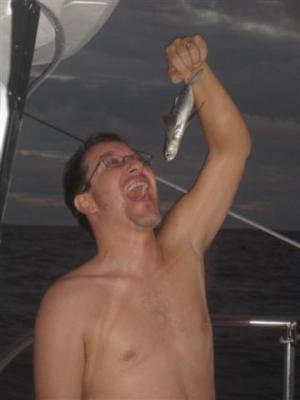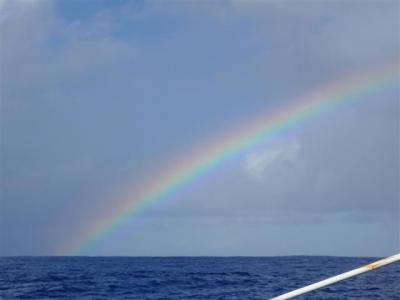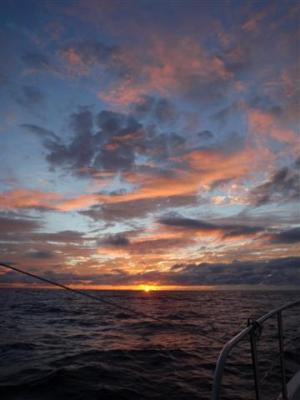Day 17 – 1000 UTC location: 17°35.00’N by 051°46.00’W and 2195 nm from Las Palmas. Yesterday’s average speed was 6.0 knots at 1600 RPM.
Conditions:
The wind was erratic today, moving from starboard to port and back again, but the gusts were so light at 5 12 knots that it didn’t matter much. Despite the fact that the wind had picked up some, the seas just continued to get better, though so gradually it was almost imperceptible. Wind waves were nothing, and the swells were 4 6 feet, gentle, lazy, and at long intervals. We are so happy we decided to pick a northern route. It paid off, after all. It was sunny, though heavy clouds moved in later in the day. The moon isn’t going to rise until after midnight, so as of this writing at 2200, it is pitch black outside.
News:
We managed to make contact with the sailboats today. They are also having “good motoring weather”. The fastest of the bunch is a trimaran, and it is averaging 4.5 knots. Sailors often brag to us about how much faster they go than we do. But the truth of the matter is they only go faster than us in ideal conditions, and ideal conditions are rare. We’re the tortoise that goes at a slow and steady pace and usually wins the race because of our steadiness.
We were on track to arrive in Guadalupe during the middle of the night, so we slowed down to 1550 RPM, which should get us in around dawn. We debated trying to speed up to get in before dark, but to speed up, we’d need to bring in the paravanes. We decided that we preferred the dual stabilization.
Here is a flying fish that committed suicide on our boat and a shot of tonight’s especially dramatic sunset.


Day 18 – 1000 UTC location: 17°13.00’N by 054°13.00’W and 2336 nm from Las Palmas. Yesterday’s average speed was 5.9 knots.
Conditions:
Conditions were the same through the night. This morning we had a squall hit us. It started on the starboard, moved to the nose, then moved to the port before it dissipated. We had 15 knots of wind on the nose for a while. It also brought heavy rain. Fortunately, it didn’t last long and it didn’t seem to have a lasting impact on the nice seas. After the storm, the wind was virtually dead for most of the day, and seas were at about 4 feet for swells and 1 2 feet for waves. Both wind and seas picked up a little bit in the evening, but it was still a nice ride. It was cloudy and the temperatures were pleasant. Tonight the moon again rises after midnight, so as of this writing it is pitch black. There are not any stars visible, either, which means the thick cloud cover is still over us.
News:
After the squall there was a particularly bright rainbow, with an unusually defined purple band.

Then a bit later it started. The traffic jam. We actually saw a ship! Then later a sailboat, and then another sailboat! Well, ok, not quite a traffic jam, but it was first traffic we have seen in ages. Other boats must mean we are getting close! We tried to make radio contact with the sailors, but no response. Oh, and we were still coming in “hot” (too fast), so we slowed down the RPM to 1500. We had another very dramatic sunset similar to last night’s.

And onto some blog questions:
Q: In Italy we went to a restaurant where we got yelled at by the waiters for ordering pasta. But, we didn’t know what they were saying =/
A: We have noticed that in many places in the world, waiters have no problem telling you “no”. There are certain protocols in meals, such as eating certain foods in a certain order, and they won’t let you break those protocols. So, for example, if you order a cup of tea prior to finishing your meal, they tell you no, because it is a digestives and you can’t have it until the end of the meal. But the waiters don’t always explain it nicely like that, and can sometimes be quite disdainful about your lack of etiquette. So, we’re guessing you must have done something horrendously offensive, such ordering the wrong wine with your pasta?
Q: Why do you only have three people on long passages instead of 4?
A: It is just more comfortable with three versus four on long trips. With 3, people can stay out of each others way and have some semblance of personal space, which is harder to do with four.
Q: Do your guests manage to sleep in the forward bunk when at sea?
A: On the Pacific crossing, Richard had a hard time sleeping in the forward berth, but the seas were very rough. Since then, we have had no complaints.
Q: What have you been doing to keep yourself occupied?
A: We all probably spent the biggest percentage of our time sleeping and talking to one another. Christi is trying to get caught up on writing blogs. During her writing breaks she watches a lot of movies. Eric spends a lot of time playing video games. Colin reads a lot. He has a N40 on order and spends a lot of time making sure he fully understands the different systems on board, is planning the layout of his instrument panel, and visualizing doing things on his own boat, from the mundane like showering, to securing the dinghy, cooking and oil changing. We all had our days that went by fast and our days that seemed to drag on forever. We all had our days where we enjoyed the trip and our days where we would have done anything to get off the boat.
Q: How do you stay thin when you eat so much?
A: Our beverage of choice is water and we drink a lot of it. We drink no soda and limited alcohol. We get a lot of exercise. Remember, we don’t have a car, so we have to walk most places and carry the things we buy fairly long distances. We also get exercise on the boat with all the stair climbing, moving heavy gear around, etc. Finally, we have less of an appetite on passage and don’t eat nearly as much when we are at sea.
Q: Do you use your spotlight much and would you recommend getting one?
A: We have probably only used the spotlight 10 times, but it has been useful in all those times. We would recommend having one.
